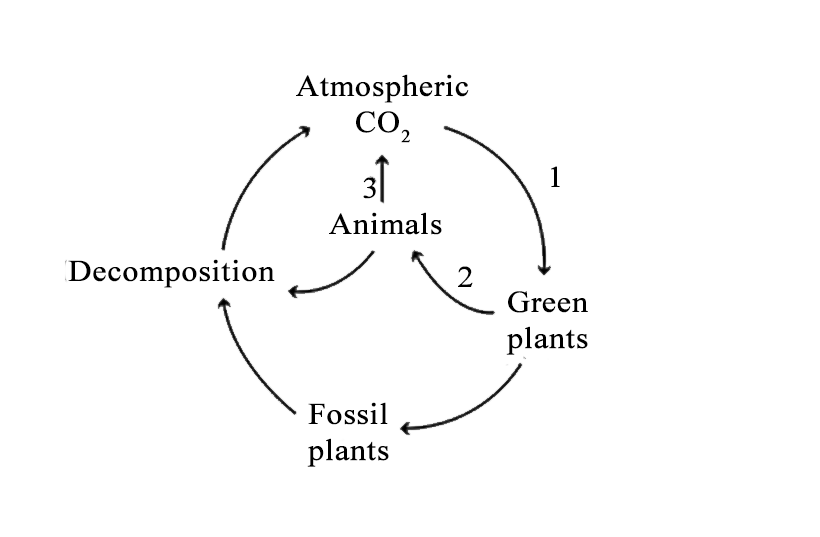
A) Name the process noted as no. 1 and 3
B) Define process 1.


Answer
594.3k+ views
Hint: The cycle where carbon c is exchanged in the earth’s atmosphere.
Complete answer:
The carbon cycle is the biogeochemical cycle by which carbon compounds are interconverted in the environment.
A) The process no 1 occurring in the carbon cycle is known as photosynthesis.
The incorporation of carbon dioxide into living tissue occurs by photosynthesis.
The process no 3 occurring in the carbon cycle is known as respiration.
The carbon dioxide after photosynthesis will return to the atmosphere through the respiration of plants and animals.
Carbon cycle consists of four major steps:
- Photosynthesis – plants pull carbon dioxide out of the air through photosynthesis and also fuels all living things as a source of energy.
- Decomposition – it is the process of breaking down plants which over years will form layers of sediments resulting in fossil fuels. The plants and animals when they die will decay and decompose.
- Respiration – breathing in oxygen and releasing carbon dioxide in the atmosphere is due to cellular respiration. This carbon dioxide produced from respiring cells can be used in photosynthesis again.
- Combustion – it is the burning of fossil fuels to produce energy and its by-product is carbon dioxide which is released back into the atmosphere.
Importance of carbon cycle
The carbon cycle is important in ecosystems because it moves carbon, a life-sustaining element, from the atmosphere and oceans into organisms and back to the atmosphere and oceans.
B). Process 1 is photosynthesis which is defined as the process by which green plants and certain other organisms transform light energy into chemical energy. It is a process by which plants make food for themselves.
Note: There are various biogeochemical cycles on earth which are:
- Water cycle
- Carbon cycle
- Nitrogen cycle
- Oxygen cycle
Complete answer:
The carbon cycle is the biogeochemical cycle by which carbon compounds are interconverted in the environment.
A) The process no 1 occurring in the carbon cycle is known as photosynthesis.
The incorporation of carbon dioxide into living tissue occurs by photosynthesis.
The process no 3 occurring in the carbon cycle is known as respiration.
The carbon dioxide after photosynthesis will return to the atmosphere through the respiration of plants and animals.
Carbon cycle consists of four major steps:
- Photosynthesis – plants pull carbon dioxide out of the air through photosynthesis and also fuels all living things as a source of energy.
- Decomposition – it is the process of breaking down plants which over years will form layers of sediments resulting in fossil fuels. The plants and animals when they die will decay and decompose.
- Respiration – breathing in oxygen and releasing carbon dioxide in the atmosphere is due to cellular respiration. This carbon dioxide produced from respiring cells can be used in photosynthesis again.
- Combustion – it is the burning of fossil fuels to produce energy and its by-product is carbon dioxide which is released back into the atmosphere.
Importance of carbon cycle
The carbon cycle is important in ecosystems because it moves carbon, a life-sustaining element, from the atmosphere and oceans into organisms and back to the atmosphere and oceans.
B). Process 1 is photosynthesis which is defined as the process by which green plants and certain other organisms transform light energy into chemical energy. It is a process by which plants make food for themselves.
Note: There are various biogeochemical cycles on earth which are:
- Water cycle
- Carbon cycle
- Nitrogen cycle
- Oxygen cycle
Recently Updated Pages
Master Class 10 General Knowledge: Engaging Questions & Answers for Success

Master Class 10 Computer Science: Engaging Questions & Answers for Success

Master Class 10 English: Engaging Questions & Answers for Success

Master Class 10 Social Science: Engaging Questions & Answers for Success

Master Class 10 Maths: Engaging Questions & Answers for Success

Master Class 10 Science: Engaging Questions & Answers for Success

Trending doubts
The shortest day of the year in India

Why is there a time difference of about 5 hours between class 10 social science CBSE

Write a letter to the principal requesting him to grant class 10 english CBSE

What is the median of the first 10 natural numbers class 10 maths CBSE

The Equation xxx + 2 is Satisfied when x is Equal to Class 10 Maths

State and prove converse of BPT Basic Proportionality class 10 maths CBSE




